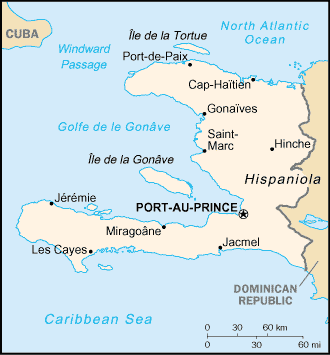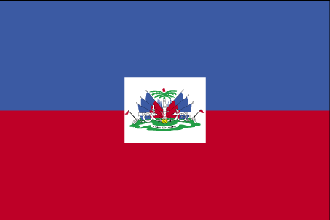
|
Haiti
Background:
The native Arawak Amerindians - who inhabited the island of Hispaniola when it
was discovered by Columbus in 1492 - were virtually annihilated by Spanish
settlers within 25 years. In the early 17th century, the French established a
presence on Hispaniola, and in 1697, Spain ceded to the French the western
third of the island - Haiti. The French colony, based on forestry and
sugar-related industries, became one of the wealthiest in the Caribbean, but
only through the heavy importation of African slaves and considerable
environmental degradation. In the late 18th century, Haiti's nearly half
million slaves revolted under Toussaint L'Ouverture and after a prolonged
struggle, became the first black republic to declare its independence in 1804.
Haiti is now one of the poorest countries in the Western Hemisphere.
Over three decades of dictatorship followed by military rule ended in 1990 when
Jean-Bertrand Aristide was elected president.
Location:
Location: Caribbean, western one-third of the island of Hispaniola, between the
Caribbean Sea and the North Atlantic Ocean, west of the Dominican Republic.
Area: Total: 27,750 sq km, land: 27,560 sq km, water: 190 sq km.
Area - comparative: Slightly smaller than Maryland.
Land boundaries: Total: 360 km, border countries: Dominican Republic 360 km.
Coastline: 1,771 km
Climate and Terrain:
Climate: Tropical; semiarid where mountains in east cut off trade winds.
Terrain: Mostly rough and mountainous.
Natural resources: Bauxite, copper, calcium carbonate, gold, marble,
hydropower.
People:
Population: 7,527,817.
Ethnic groups: Black 95%, mulatto and white 5%.
Religions: Roman Catholic 80%, Protestant 16% (Baptist 10%, Pentecostal 4%,
Adventist 1%, other 1%), none 1%, other 3%, note: roughly half of the
population also practices Voodoo.
Languages: French (official), Creole.
Government:
Government type: Elected government.
Capital: Port-au-Prince.
Independence: 1 January 1804 (from France).
National holiday: Independence Day, 1 January (1804)
Economy overview:
About 80% of the population lives in abject poverty. Nearly 70% of all Haitians
depend on the agriculture sector, which consists mainly of small-scale
subsistence farming and employs about two-thirds of the economically active
work force. Following legislative elections in May 2000, fraught with
irregularities, international donors - including the US and EU - suspended
almost all aid to Haiti. The economy shrank an estimated 1.2% in 2001 and an
estimated 0.9% in 2002.
Statistics:
Telephones - main lines in use: 60,000.
Telephones - mobile cellular: Over 180,000.
Radio broadcast stations: AM 41, FM 26.
Radios: 415,000.
Television broadcast stations: 2 (plus a cable TV service).
Televisions: 38,000.
Internet users: 30,000.
Railways: Total: 40 km.
Highways: Total: 4,160 km, paved: 1,011 km, unpaved: 3,149 km.
Airports - with paved runways: 2, with unpaved runways: 10.
Return to Visiting Locations
|

